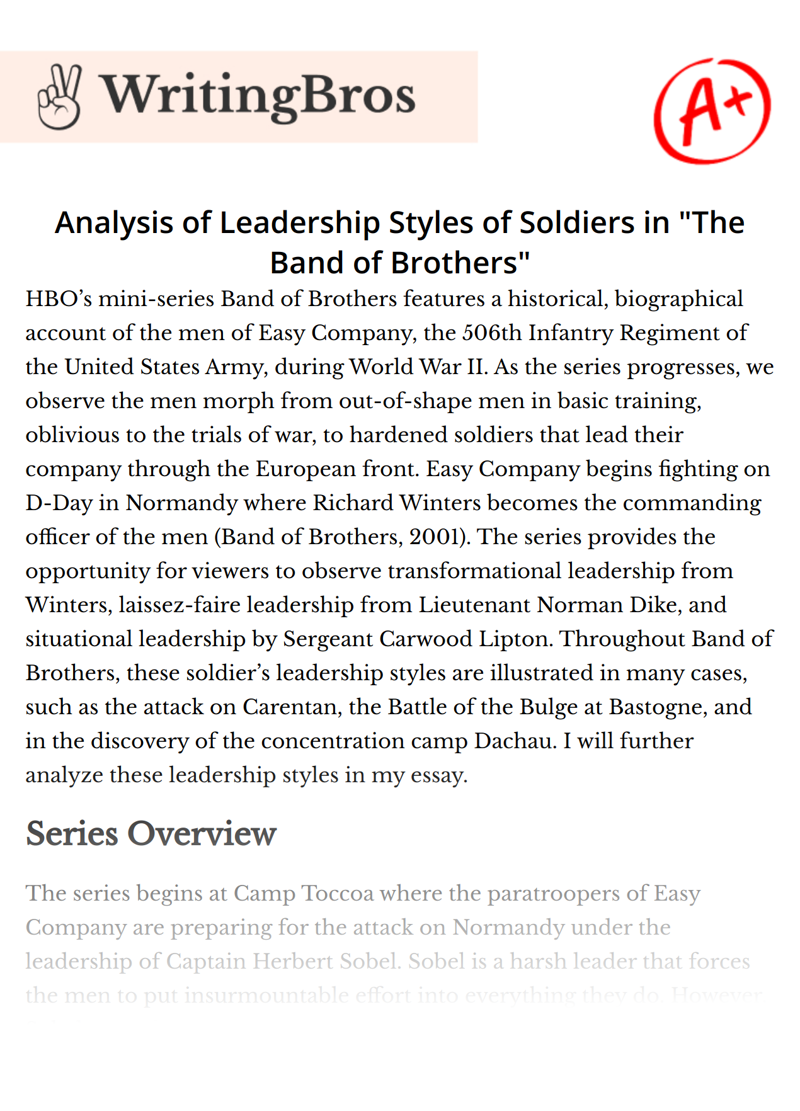Analysis of Leadership Styles of Soldiers in "The Band of Brothers"

Table of contents
HBO’s mini-series Band of Brothers features a historical, biographical account of the men of Easy Company, the 506th Infantry Regiment of the United States Army, during World War II. As the series progresses, we observe the men morph from out-of-shape men in basic training, oblivious to the trials of war, to hardened soldiers that lead their company through the European front. Easy Company begins fighting on D-Day in Normandy where Richard Winters becomes the commanding officer of the men (Band of Brothers, 2001). The series provides the opportunity for viewers to observe transformational leadership from Winters, laissez-faire leadership from Lieutenant Norman Dike, and situational leadership by Sergeant Carwood Lipton. Throughout Band of Brothers, these soldier’s leadership styles are illustrated in many cases, such as the attack on Carentan, the Battle of the Bulge at Bastogne, and in the discovery of the concentration camp Dachau. I will further analyze these leadership styles in my essay.
Series Overview
The series begins at Camp Toccoa where the paratroopers of Easy Company are preparing for the attack on Normandy under the leadership of Captain Herbert Sobel. Sobel is a harsh leader that forces the men to put insurmountable effort into everything they do. However, Sobel struggles as a leader in battle situations, so he is removed as commanding officer before D-Day. On D-Day, the men are separated, and Lieutenant Richard Winters leads many of Easy’s men back together, becoming the commanding officer of the company. The men flourish under Winters’ leadership, orchestrating successful attacks in Normandy, Carentan, and Bastogne, among others. Before the Battle of the Bulge at Bastogne, Winters is promoted to commanding officer of the battalion, leaving Easy Company. After the quick death of another officer, he is replaced by First Lieutenant Norman Dike, a man who has little knowledge on how to lead men or how to act on the battlefield and is not well respected by his soldiers. During this battle, First Sergeant Carwood Lipton picks up the slack and leads the men in ways an officer usually would. After Bastogne, Dike is chosen to lead the assault on Foy, where he ultimately fails and is replaced by Lieutenant Spiers. Spiers leads a successful mission and is promoted to commanding officer of Easy Company. After the assault on Foy, the war begins to dwindle, and the men are faced with few more attacks. The climax of the series occurs when the men of Easy Company discovers a Nazi concentration camp where people are malnourished and dying, among other atrocities. As the war ends, Easy Company remains in Europe and many men are seen committing acts of stupidity and violence while they await heading home (Band of Brothers, 2001).
Army Leadership Styles
Richard Winters
Throughout Band of Brothers it is clear to the casual viewer that Richard Winters is the epitome of a great transformational leader. In an article in the Air and Space Power Journal, researchers claimed that the four keys to transformational leadership are inspirational motivation, idealized influence, intellectual stimulation, and individual consideration (Sosik, Arenas, Jae Uk Chun, & Ete, 2018). Winters clearly illustrates each of these components of transformational leadership throughout the war. In the episode “Crossroads,” Winters is seen running first into battle ahead of his men with no regard for his own safety or protection even though he is the commanding officer of the company (Band of Brothers, 2001). This action inspired to defeat an enemy that significantly outnumbered them. As for idealized influence, Winters continuously builds the brotherhood of the men in Easy Company. As the leader, he is tasked with ensuring the men stay close and fight for one another.
Aside from his own attempt of building a tight-knit group, he successfully delegates some of this work to the Sergeants, especially Carwood Lipton. Winters confronts the intellectual ability of those under him in many situations. When the men liberated the concentration camp in Germany, Winters challenged Liebgott translate to the prisoners the message that they must return to the camp in order to ensure their health. Although Liebgott did not want to convey this message, Winters instilled the courage in him to do it anyway. The best skill Winters possessed; however, was the ability to have individual consideration of each man he was around. Whether it be a private or a general, if the soldier did what he was ordered, Winters exhibited the utmost respect for them. When Blithe was terror-stricken in “Carentan,” Winters went out of his way to ensure Blithe demonstrated his full ability. Throughout the episode, Winters provides the individual consideration for him to display his unique abilities on the battle field. Each of these examples prove that Richard Winters is the pinnacle of transformational leadership, as he morphed the men around him into better people.
Norman Dike
The antithesis of Major Richard Winters in Band of Brothers is Lieutenant Norman Dike, an ivy-league-graduate turned lieutenant in World War II. Dike illustrates exactly what a laissez-faire leader is presumed to do, be absent, both mentally and physically, in moments of need. Researchers Zareen, Razzaq, and Mujtaba described laissez-faire leadership as a style that delegates all of the power to the subordinates in the organization (Zareen, Razzaq, & Mujtaba, 2015). Dike’s repeated disappearances led the enlisted men under him to constantly ask “Where’s Dike?” and have to fill in for him when providing orders to the lower-ranked enlisted men. Dike unknowingly gave all of the power in the company to non-commissioned officers such as Lipton, Compton, and Guarnere when he disappears during the Battle of the Bulge. A team of researchers from the University of Bergen in Norway discovered that laissez-faire leadership is conducive of a stressful, ambiguous work environment where subordinates are left with few orders on how to properly perform their roles (Skogstad, Hetland, Glasø, & Einarsen, 2014). Dike freezes on the battlefield in Foy and gives the ambiguous response “I don’t know, I don’t know” to enlisted men when asked for battle plans, increasing the stress of the situation. Dike’s lack of ability to connect with his men leads to his failure as Easy Company’s commanding officer.
Carwood Lipton
The enlisted man with the most significant leadership in Band of Brothers is Sergeant Carwood Lipton, a Toccoa man who entered as a private. Under Lieutenant Dike’s lax form of leadership, Lipton displays evident situational leadership. Researcher Jim McCleskey delves into the topic of situational leadership in an article in The Journal of Business Studies Quarterly, claiming that good situational leaders are able to assess the situation in which they are in and make sound decisions based on that judgement (McCleskey, 2014). One example of Lipton displaying his situational leadership skills is when he reports Hoobler’s death to Winters in Dike’s absence. Although normally an officer would deliver this news, Lipton resolves that he is the best man to do it in the place of Dike.
Richard Winters
The Army Leadership Requirements Model, or ADRP 6-22, displays exactly how the Army believes its soldiers instill leadership in others. The ADRP claims that leaders are excellent once they discipline their followers to abide by Army values, do their duty, and have the belief they can commit to any mission (“ADRP 6-22 Army Leadership,” 2012). As seen in the series, Winters maintains the ability to lead his men to accomplish things they would never imagine. During the assault on Foy, Winters picks Spiers to fill in for Dike, instilling confidence in Spiers and revealing his personal sense of trust in him. One of the main points in The Five Practices of Exemplary Leadership is “Enabling Others to Act” (Kouzes & Posner, 2009), and this instance can clearly be seen as Winters successfully enabling Spiers to act in this battle.
Norman Dike
Lieutenant Dike does not accomplish any of The Five Practices of Exemplary Leadership. The practice Dike botches the most is “Modeling the Way” (Kouzes & Posner, 2009). Dike’s prevalent absence reveals that he is an unsuccessful role model for everyone in the company. Rumblings about his failure as a leader among privates are clear evidence that he does not inspire anyone to be like him. Being a role model is also a prevalent topic in ADRP 6-22, as there are seven separate discussions on role models throughout the paper. The ADRP 6-22 describes being a role model as someone who “maintains standards and provides effective examples through their actions” (“ADRP 6-22 Army Leadership,” 2012). Dike fails to maintain the standards of the Army and is often the laughingstock of the company; therefore, he is not a successful role model at all.
Carwood Lipton
The Army Leadership Requirements Model, or ADRP 6-22, displays exactly how the Army believes its soldiers should lead their subordinates. The ADRP 6-22 suggests “being a good subordinate is part of being a good leader” (“ADRP 6-22 Army Leadership,” 2012). Lipton is seen throughout Band of Brothers as a good subordinate to Winters and the other officers, performing the necessary tasks they assign him while also leading the enlisted men beneath him. Lipton’s ability to be a good subordinate reinforces the idea of being a good subordinate to the men he leads, effectively creating a more cohesive atmosphere. This cohesive atmosphere “Encourages the Heart” (“57901.pdf,” n.d.) of the men, allowing them to accomplish extraordinary achievements throughout the war.
Conclusion
This paper has detailed the leadership styles of Richard Winters, Norman Dike, and Carwood Lipton. Winters represents an officer who displayed constant, transformative devotion to the development of his men. Dike was a failing leader whose ignorance led to the failure of Easy Company under his lead until his replacement. Finally, as a non-commissioned officer, Lipton performed duties an officer generally would while still maintaining his role as the chief enlisted man in the company.
As an observer of Band of Brothers, I have determined that I will use analysis of the leadership of Winters and Lipton to apply to my own leadership style. I will work to enhance both my situational and transformational leadership skills based on the actions of Winters and Lipton. Actions speak louder than words, so in order to achieve this, I must put myself to the test to attain similar leadership ability.
References
- Ambrose, S. E. (1992). Band of Brothers: E Company, 506th Regiment, 101st Airborne from Normandy to Hitler's Eagle's Nest. Simon and Schuster.
- Black, P. (2012). Transformational leadership: How leaders can get extraordinary results from ordinary people. AMACOM.
- Bowers, C. A., Pharmer, J. A., & Salas, E. (2000). When member homogeneity is needed in work teams: A meta-analysis. Small Group Research, 31(3), 305-327.
- Ender, M. G. (2002). An introduction to military ethics: A reference handbook. ABC-CLIO.
- Lepsinger, R., & Lucia, A. D. (2009). The Art and Science of 360 Degree Feedback. John Wiley & Sons.
- Ryan, K. (2015). 10 Characteristics of Successful Leaders. [online] Forbes. Available at: https://www.forbes.com/sites/kevinkruse/2015/04/27/10-characteristics-of-successful-leaders/?sh=20564e8d7dd4 [Accessed 21 Apr. 2023].
- Schmid, M., O'Brien, J., & Gower, K. K. (2019). The Handbook of Military Social Work. John Wiley & Sons.
- Thayer, B. A. (2010). Leadership characteristics of successful combat veterans. Military Review, 90(4), 66-73.
Cite this Essay
To export a reference to this article please select a referencing style below

